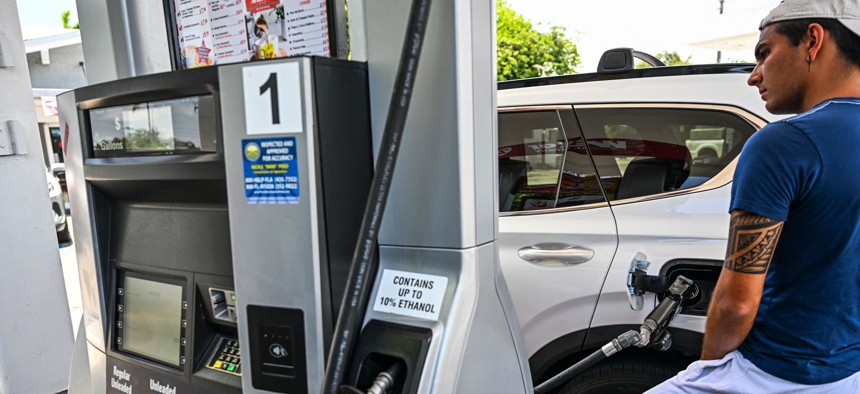Florida gasoline prices dip to lowest level since January
The average price was down from $3.41 a week earlier and $3.61 a month earlier.

A person pumps gas into his car at a gas station in Miami, Florida, on July 19, 2022. Photo by CHANDAN KHANNA/AFP via Getty Images
The average price of a gallon of regular unleaded gasoline in Florida was $3.38 on Monday, the lowest price since January, according to the AAA auto club. The average price was down from $3.41 a week earlier and $3.61 a month earlier.
Florida hit a record high of $4.89 a gallon on June 13, but prices steadily decreased through the summer. AAA spokesman Mark Jenkins said Hurricane Ian is unlikely to cause price hikes because refineries in Louisiana, Mississippi and Texas will not be affected.
"There's actually downward pressure on pump prices, despite the forecast that a hurricane would approach Florida this week," Jenkins said in a statement. "Gasoline and oil futures prices plunged 7 percent last week, to eight-month lows on concerns that aggressive interest rate hikes by the U.S. Federal Reserve could trigger an economic recession."
The most-expensive gas in Florida is in the West Palm Beach, Tallahassee and Gainesville markets, while the least-expensive gas is in the Pensacola, Fort Walton Beach and Panama City markets, according to AAA.
Regional Prices
- Most expensive metro markets – West Palm Beach-Boca Raton ($3.57), Tallahassee ($3.47), Gainesville ($3.45).
- Least expensive metro markets – Pensacola ($3.17), Crestview-Fort Myers ($3.18), Panama City ($3.26).
Here's more from the AAA press release:
In the coming days, it's possible that gas stations will temporarily run out of fuel, due to an influx in demand from evacuees or people topping off their tanks and filling spare gas cans. However, it's also important for drivers to remember that these outages are temporary.
Gas stations are not connected to an underground pipeline. Just like your vehicle, each gas station can only hold so much fuel at a given time. That fuel is stored in tanks underground. Once those tanks are empty, retailers bag the pumps and wait for the next delivery truck. Sometimes that can be the same day, sometimes longer. It can vary.
Florida’s gasoline is primarily provided by refineries in Texas, Louisiana, and Mississippi. That gasoline sails into Florida’s ports, then is picked up by tanker trucks and delivered to area gas stations. Fuel deliveries should continue until the weather conditions make it unsafe to do so.
Once the storm passes and the ports reopen, shipments of gasoline will begin flowing into the state again. Gasoline can also be driven over from surrounding counties or states that are not impacted by the storm.
"The bottom line is, don't panic about gasoline supplies, just take what you need," Jenkins said. "The state makes it a priority to keep gasoline shipments going as long as it's safe to do so. Once the storm passes, shipments will resume as soon as possible."
This is a free News Service of Florida story for City & State Florida readers. For the most comprehensive and in-depth political and policy news, consider a subscription, beginning with a 10-day free trial. Click here to sign up!
NEXT STORY: Trickle of ballots starts in Florida general election; U.S. Sugar deal gets OK